Cadarache, in the South of France not far from Marseilles, is the site of Iter, the international experiment to build and operate the world’s largest nuclear fusion reactor, to test whether fusion can be a practical method of energy generation; the site is a sunny plateau amid forested hills, with Alps gleaming blue and white in the distance.
The landscape seems parched; the site has been levelled to expose the bare sandstone bedrock, and the (so far) relatively few buildings on the site stand out starkly against the beige ground.
At first glance, there’s little to see. The main focus of activity is what will be the complex that house the fusion machine itself. Iter — originally an acronym for International Thermonuclear Experimental Reactor — is a tokomak, a device which triggers fusion in a plasma, a gaseous mixture of charged subatomic particles made from a mixture of two different types of hydrogen, by confining the plasma within a toroidal vessel and squeezing it with powerful magnetic fields while heating it up. It will be the world’s largest tokomak with an internal radius of 6m, in total some 19m across and 11m high, enclosing a volume of 1400m3; the electromagnets that will confine the plasma and force it to spin inside the torus will be superconducting, cooled by liquid helium to a few degrees above absolute zero to eliminate the need to supply them constantly with electric current.
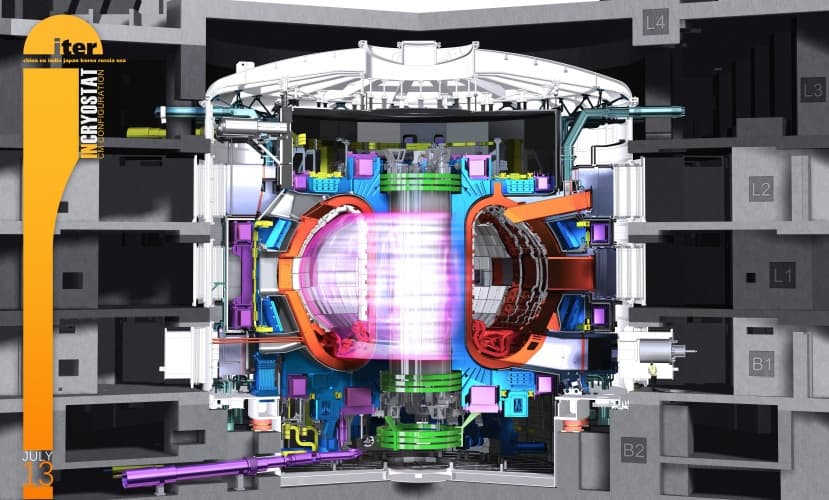
This system for fusion, known as magnetic confinement, isn’t the only method known, but it’s been developed over more than half a century in many locations around the world; Iter’s management maintain that it is the most likely to yield commercial fusion in the shortest time. Other methods use forces created by powerful lasers or electrical fields to contain the plasma of deuterium and tritium — isotopes of hydrogen with one and two neutrons in their nuclei respectively — that fuse together to form helium and release energy.
Field of its own
The first components of Iter’s complex magnets reveal just how large the tokamak will be
Even visiting the Cadarache site, it’s difficult to grasp just how large the fusion machine will be. Viewing the tokamak pit from a distance doesn’t quite give you the idea. The only way to really get it is to get up close to actual components.
The nearest component manufacturing site to the Iter site itself is CNIM, a metalworking specialist along the coast from Marseille. Here, the radial plates for the superconducting toroidal field magnets are being machined. The toroidal magnets are the ones which wrap around the ‘body’ of the doughnut-shaped vacuum vessel, running up the inside surface, over the top, down the outer curve and underneath the diverter (the trench-shaped component at the bottom of the tokamak where the hot plasma comes into contact with the vessel wall). The radial plates are thick steel hoops which hold the coils of the magnet in grooves, one on each side of the plate. Each of the 18 toroidal field coils that makes up the entire magnet will contain seven radial plates stacked together in a housing which also contains the conduits for the liquid helium which will cool the coils of superconducting cable. European companies are making 10 of these coils.
The radial field plates are made from stainless steel forgings made by hot isostatic pressing which are delivered to CNIM in several sections. These are loaded into a machine tool in a vertical configuration and grooves – which appear parallel but actually form spiral when the sections are joined together — are milled into them. The milled sections are then loaded into a jig in a horizontal configuration and are welded together using full-thickness electron beam welding.
It’s at this point that the size of the component becomes clear. Each D-shaped hoop, shown below, is 15m along its long axis and 8.5 on the short, and the whole piece takes more than a minute to walk around.
After welding, the plates are transported to another machine tool, where the grooves are widened and shaped to the size required for the cable coil. These are being wound by Italian company SIMIC, and the precise measurements of each coil are sent to CNIM so the corresponding plate can be machined for an exact fit. Small sections of stainless steel are then machined to form a cover for the coil, again to the exact specifications of each individual coil.
After finishing, the hoops will be loaded onto a barge and shipped to SIMIC for assembly. In an excellent demonstration of the multinational nature of Iter, the cases for the toroidal coils, into which the radial plates will be packed, are being made in Japan; the plates will have to be fitted into the case with sub-millimetre precision and the cases welded shut, then the spaces between coil pack and case filled with a resin the consistency of thick honey. The total mass of each coil pack is 340tonnes — returning to the airliner comparison, about the same as six Boeing 737s. The thermal shields of the vacuum vessel, which will be welded onto the coils, are being made in South Korea.
In operation, the coils will be cooled to about -200°C, while the plasma — some 50cm — away will be at 150million°C, heated by accelerating it around the torus while bombarding it with microwave energy and injecting frozen pellets of deuterium.
Currently, the building site is the domain of civil engineers, working in a 30m-deep pit blasted out of the rock to construct the foundations of the tokamak complex. Once complete, this will be a dense tangle of equipment and facilities, so this is a rare chance to see the bones of the building take shape.
The tokamak complex is in fact four main buildings sharing a single monolithic structure. In the centre is the tokamak building itself, where the machine will be housed; flanked to the West by the diagnostic building where the machines’ running will be overseen and to the East by the tritium plant, where this radioactive component of the machine’s fuel will be processed and handled. To the South is the assembly hall, where the components of the machine will be pieced together in the construction phase of the project before being lifted into the tokamak pit. But the main focus is the foundations of the tokamak pit itself.
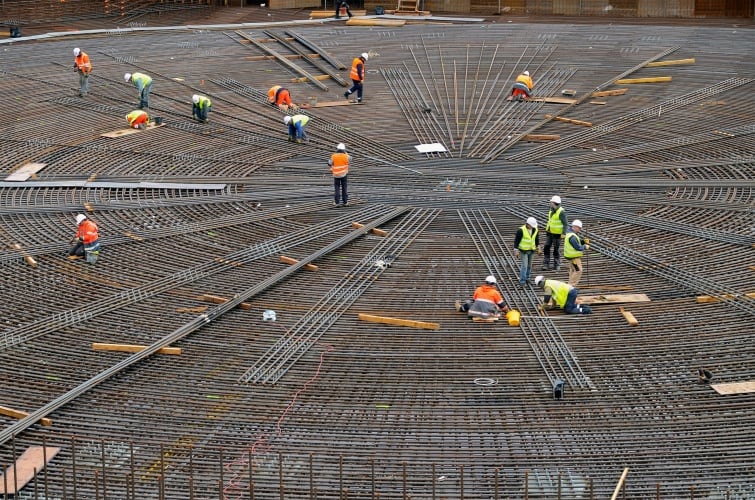
The massive machine, weighing roughly the same as a fully fuelled and loaded Boeing 747, sits on a basemat of concrete 1.5m thick. On top of this are 493 columns topped with anti-seismic pads: alternate layers of steel and rubber whose top layer can move by 10cm laterally; these will absorb any ground motion in case of earthquakes.
On top of these columns will sit the B2 basemat — the concrete floor on which the tokamak itself will sit. The construction of this is currently underway, and it’s this which can be seen from the viewpoints overlooking the site. The basemat will have to cope with the forces imparted by the fusion machine; not just its weight, but the forces resulting from the electromagnetic effects of the movement of the plasma and its interaction with the tokamak’s three sets of massive electromagnets (one in the middle of the torus, another set ringing the outer circumference and a third set running perpendicular to that, from the outer wall over the top, down the middle and back underneath). This requires some heavy civil engineering.
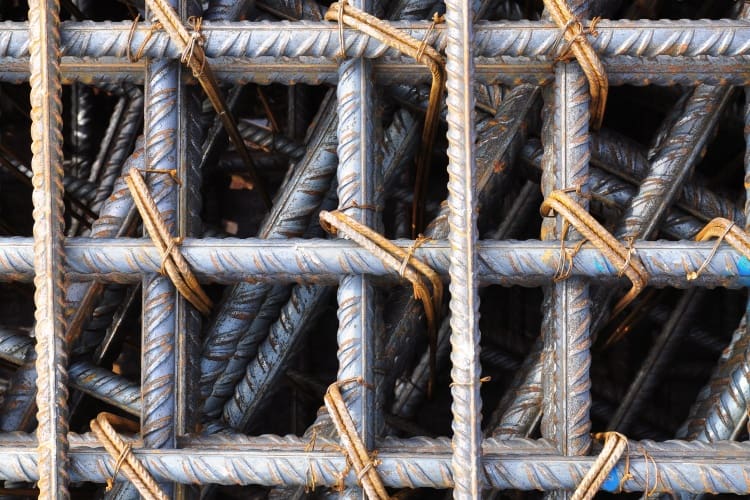
Like most large structures, the B2 mat is made of steel-reinforced concrete. This will be poured onto a wooden former deck, which is supported by a forest of timber joinery filling the spaces around and between those 493 seismic columns. On top of this is a dizzyingly complex spiderweb of steel rebar — ribbed steel bars 40mm thick placed in a precise pattern which corresponds to the forces that will be acting on the slab. Laurent Patisson, a seismic building specialist who is responsible for the ‘nuclear buildings’ on the Iter site (which come under the purview of the French nuclear regulatory authorities) explained that the form follows the layout of what will sit above it.
Patisson has had extensive experience with the nuclear sector in France; he used to work at CEA, the nuclear research facility adjoining the Cadarache site. He was also involved in the seismic survey of the site to acertain the earthquake risk. He works for the European company delivering Iter, Fusion 4 Energy, which is subcontracting Spanish civil engineering firm Ferrovial and Britain’s Atkins, which is assisting in p;roject management.
‘The outer walls of the tokamak building are square, and 1.5m thick,’ Patisson told The Engineer. ‘Then inside that you have another concrete wall which surrounds the tokamak itself; that’s called the bioshield wall because it protects the staff from the neutron radiation from fusion and the radioactivity of the tritium. The bioshield is extended with corridors that are the way onto the machine for equipment and maintenance; we call those portcells.’
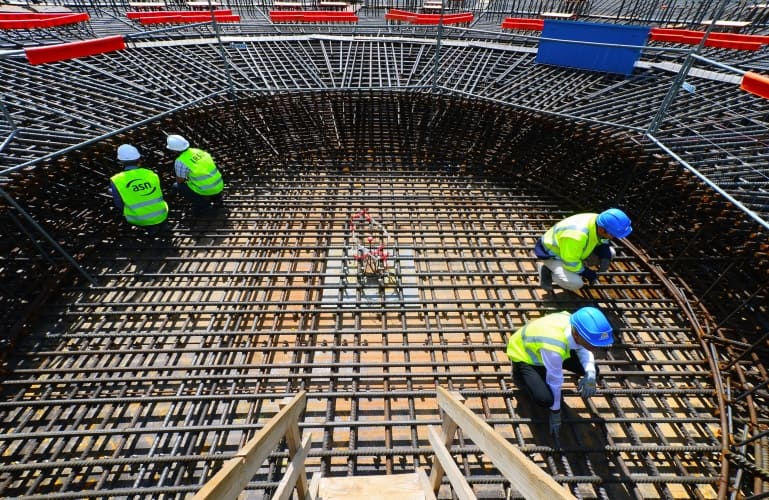
This circular structure and the electromagnetic forces from the tokamak, which are radial and whose influence extends to a 30m radius from the machine, mean that a component of the reinforcement for the basemat also has to be radial, hence the concentric circles of rebar in the basemat construction. But the as the building itself — which is also a very heavy construction — is square, this needs to be supported by orthogonal reinforcement, hence the gridwork pattern overlying and threaded through the circular layers. ‘We have up to 26 layers of rebar in some areas,’ Patisson said. The 40mm thickness of the bars is standard for infrastructure concrete — like bridges — but on top of the mat we’ll be buildings some radial walls that are part of the supporting structure for the tokamak, and they’ll have 50mm reinforcement. That’s not common at all.’
The tokamak building will contain contains some 16,000 tonnes of rebar, of which the basemat constitutes a significant fraction. Some of the gaps into which the concrete making up the mat itself will be poured are less than 25mm wide. Iter has its own on-site concrete batching plant where the many thousands of tonnes of the material are being mixed. ‘Over 95 per cent is conventional concrete, with aggregate — which is actually the ground-up bedrock we removed to make the pit — mixed with cement and fillers. It’s what we prefer to use for nuclear installations, because we understand it well, although it has to be qualified for the regulator. Fluidity is a most important parameter, because it has to flow into that very dense arrangement of rebar with no voids or bubbles.’ The cement component is formulated to minimise heating as it cures, to prevent expansion and shrinkage of the rebar, and vibration equipment will be used to help the concrete settle into the space as it is poured.
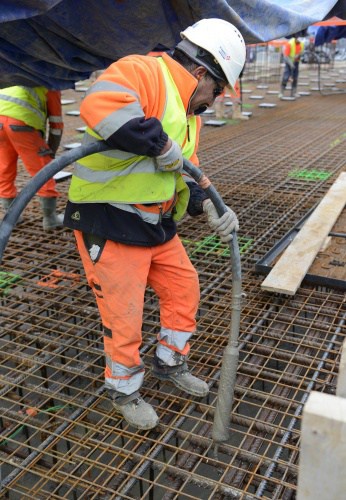
The B2 area, roughly the size of a football pitch, is divided into 15 sectors, which will be poured individually. ‘Each will take a day to pour, and should be set in 10-15 days, but we’ll wait in some cases for up to 28 days before pouring an adjacent sector,’ Pattison said. Grouting will be used between sectors to ensure leak-tightness.’
In all, it will take about three months to pour the entire basemat. Pattison insists that this is all conventional civil technology, albeit to a much higher level of complexity. ‘I believe it’s the most complex reinforced concrete mat ever made,’ he said.
Once set, the integrity of the concrete cannot be damaged, so it can’t be drilled to anchor the tokamak equipment. Instead, steel plates — mostly carbon steel, but a few stainless — will be embedded directly into the wet concrete, and equipment will be welded onto them. Embedded plates will also be used in the walls of the building. ‘It’s concrete and steel, so in that sense it’s simple,’ Pattison said. ‘But the loading is very large and not obvious. We’re setting that standards for something that has never been done before.’
Breeding Programme
Iter will conduct the first tests of technology to generate radioactive tritium within the fusion reactor
Among the most challenging technologies on Iter are the breeder blanket test modules. These will generate tritium, the heavy isotope of hydrogen, a process which will be vital if fusion is to become a commercial reality.
Of the two components of fusion fuel, deuterium — hydrogen with a neutron in its nucleus — is readily available in seawater. But tritium does not occur in nature. It’s made inside specialised fission reactors, so is scarce and expensive. It’s also dangerous, because it’s radioactive.
Commercial fusion reactors will have to make their own tritium. The fusion reaction of deuterium and tritium creates helium and a high-energy neutron, and if collides with a lithium nucleus it converts it into tritium.
A commercial fusion reactor would generate all of its tritium this way, with its blanket — the component which covers the inside of the vacuum vessel, protecting it from the plasma and its heat, and containing the coolant circuits which would carry the fusion heat away from the reactor so that it could be used to raise steam for electricity generation — studded with breeder units where lithium can come into contact with neutron flux. But Iter will only test this technology, with three ports housing modules which will test different breeder technologies.
‘We need simple designs if possible, to minimse the cost of fabrication,’ said Rene Raffray, who heads Iter’s blanket section. ‘There are several options: having the lithium in a ceramic material, such as silicate or titanate; a liquid eutectic alloy, such as Pb-17Li [lithium-lead], which is immune to neutron irradiation; or further into the future materials based on silicon carbide or SiC composites.’
Initially Iter will test the first two of these, using modules made from ferritic-martensic steel, which resists activation by neutron flux. The ceramic will be in the form of pebbles of lithium titanate (Li2TiO) containing as an additive beryllium, which acts as a neutron multiplier, spewing out more high-energy neutrons when one strikes its atoms. These will be water-cooled. European nations will build lithium-lead eutectic units, where the metallic liquid itself acts as a coolant. ‘Helium gas will flow through the breeder units as a purge gas; this will carry the tritium out as it is generated where it can be separated in the tritium plant,’ Raffray said.
Although ferritic-martensic steel is fine for use in Iter, its planned successor, DEMO, envisaged as the first fully-operational fusion power station, will operate at higher temperatures and with continuous fusion rather than pulsed. This would be too much for steel to cope with in close proximity to the plasma, which is where silicon carbide comes in. ‘It needs a lot of development, so it’s high risk, but equally high pay-off,’ Raffray said. ‘It can operate at very high temperatures, which means that the efficiency of heat transfer is very high – 55-60 per cent, compared with 44 per cent for steel.’




Glasgow trial explores AR cues for autonomous road safety
They've ploughed into a few vulnerable road users in the past. Making that less likely will make it spectacularly easy to stop the traffic for...